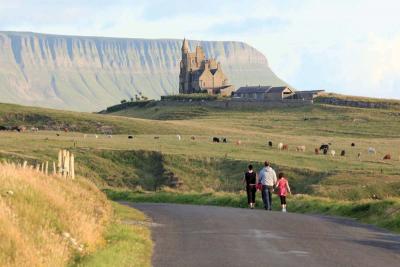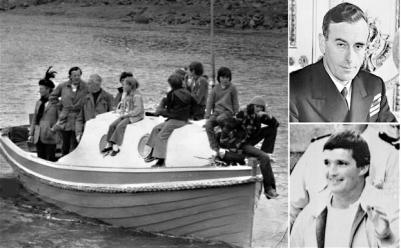April 30, 2015
 Classiebawn, the home of Lord Mountbatten in Mullaghmore, County Sigo, was built in the 1860’s by twice Prime Minister of England, Lord Palmerston. Prince Charles will be visiting Sligo this month where Lord Mountbatten was assassinated in 1979.
Classiebawn, the home of Lord Mountbatten in Mullaghmore, County Sigo, was built in the 1860’s by twice Prime Minister of England, Lord Palmerston. Prince Charles will be visiting Sligo this month where Lord Mountbatten was assassinated in 1979.
DUBLIN – Prince Charles is expected to visit the scene of the Irish Republican Army’s most high-profile assassination – the 1979 slaying of Charles’s great-uncle, Lord Mountbatten – during an official visit to Ireland this month to Ireland.
The British and Irish governments said that details are still being confirmed for Charles’s tour involving Co. Sligo in western Ireland, where Mountbatten lived without security in a castle residence for many years despite the IRA threat.
The outlawed group killed the 79-year-old World War II hero and Britain’s last viceroy of India, and three other people, by detonating a remote-control bomb hidden aboard his yacht in the port village of Mullaghmore.
At the time, Sinn Fein politician Gerry Adams justified Mountbatten’s killing. ``With his war record I don’t think he could have objected to dying in what was clearly a war situation. He knew the danger involved in coming to this country,’’ Adams said.
Charles has been the diplomatic trailblazer for the British royal family in Ireland. In 1995, a year after the dominant branch of the IRA called an open-ended cease-fire, he became the first British royal since Irish independence in 1922 to pay an official visit to the republic. Charles made a second official visit in 2002 that paved the way for his mother, Queen Elizabeth, to make a state visit across Ireland in 2011.
This will be the first joint visit to the Republic of Ireland by Charles and his wife Camilla, the duchess of Cornwall. Sligo is famed as the setting for much of the poetry of W.B. Yeats, who is buried there, for historically significant country homes – and, improbably, for Ireland’s most vibrant surfing scene.
The two governments have confirmed that the couple will visit both the republic and Northern Ireland May 19-22. Royal visits to Northern Ireland, a part of the United Kingdom, are common.
Classiebawn, that great impressive hulk of Mountcharles sandstone, was built in the 1860s by twice Prime Minister of England, Lord Palmerston,
Lord Mountbatten was a regular visitor to Mullaghmore in North Sligo where he owned a fishing vessel known as the Shadow V. Before his assassination on Aug. 27, 1979, Mountbatten had been warned about visiting Sligo by Gardaí, but he went out fishing that day anyway.
Thomas McMahon, an IRA member and the man who was charged with killing Mountbatten, fitted a radio-controlled bomb to the Shadow V the evening before. The next morning the bomb was detonated as Mountbatten made his way into Donegal Bay. 14-year-old Nicholas Knatchbull was killed instantly, along with Paul Maxwell from Fermanagh. Mountbatten survived the explosion but later died from his injuries along with Lady Brabourne.
 Mountbatten: August 1979: Lord Mountbatten (top right) with members of his family aboard the boat that was blown up by members of the IRA and Thomas McMahon (bottom right) who was convicted of the murders in 1979 of Lord Mountbatten and three other people.
Mountbatten: August 1979: Lord Mountbatten (top right) with members of his family aboard the boat that was blown up by members of the IRA and Thomas McMahon (bottom right) who was convicted of the murders in 1979 of Lord Mountbatten and three other people.
In the wake of the explosion, the IRA claimed responsibility for the attack. They issued a statement saying “the IRA claim responsibility for the death of Lord Mountbatten. This operation is one of the discriminate ways we can bring to the attention of the English people the continuing occupation of our country.”
On the same day as the explosion in Mullaghmore, 18 British soldiers were killed in an ambush that became known as the ‘Warrenpoint Ambush’.
In 2014, Ireland President Michael D. Higgins paid a silent tribute to Lord Mountbatten when he was on an official State visit at Westminister Abbey where there is a memorial to the one-time Viceroy of India and Allied theater commander during World War II. Classiebawn, the home of Lord Mountbatten in Mullaghmore, County Sigo, was built in the 1860’s by twice Prime Minister of England, Lord Palmerston. Prince Charles will be visiting Sligo this month where Lord Mountbatten was assassinated in 1979.
Classiebawn, the home of Lord Mountbatten in Mullaghmore, County Sigo, was built in the 1860’s by twice Prime Minister of England, Lord Palmerston. Prince Charles will be visiting Sligo this month where Lord Mountbatten was assassinated in 1979.

